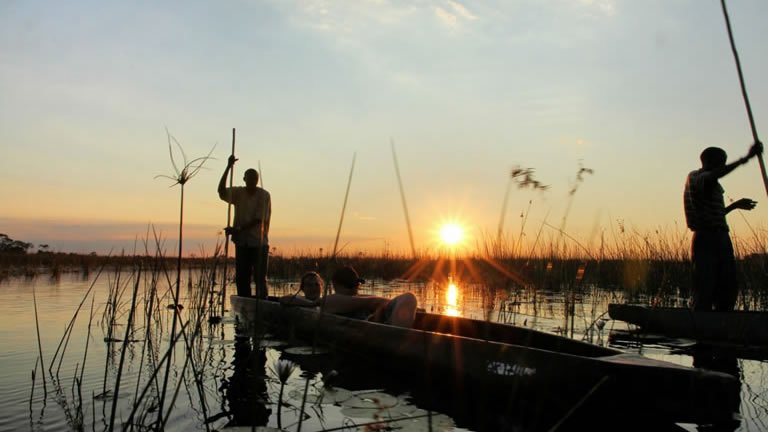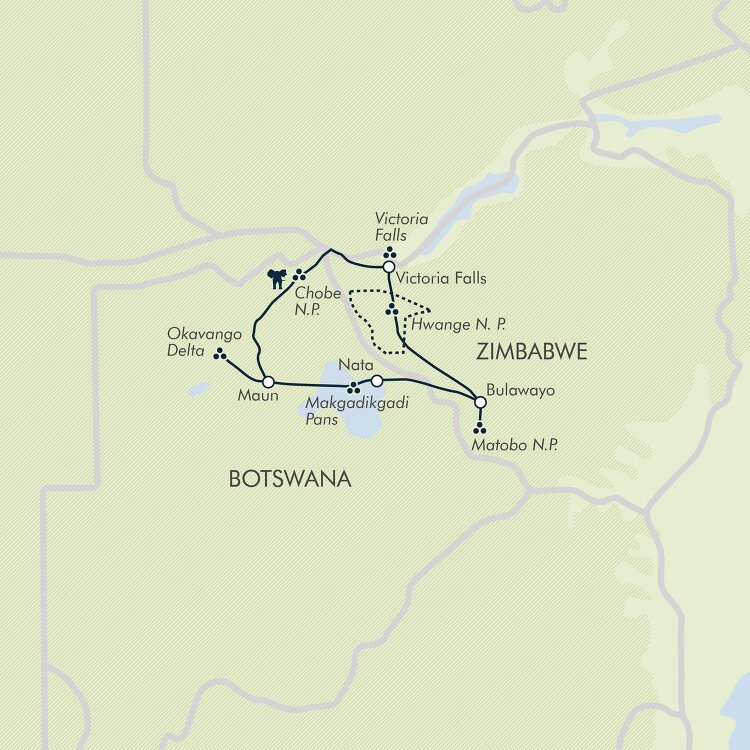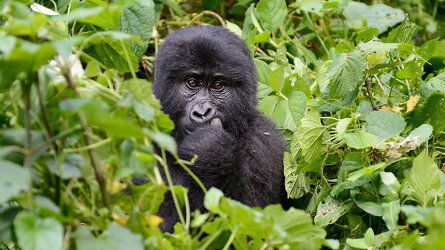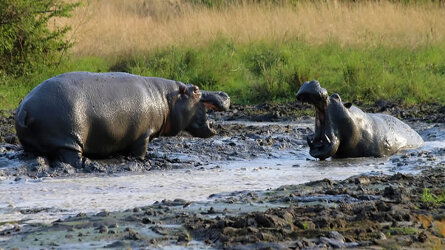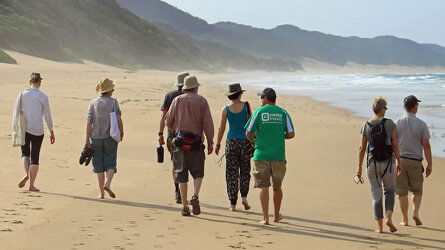Overview
Itinerary
Meet the group at the airport or at the Rainbow Hotel in Victoria Falls town (see the Joining Instructions for more information, as the airport can sometimes change). We then transfer 75mi (120km) to Kasane, Botswana. The drive takes a little over two hours but there can be delays crossing the border. Once we are settled into our chalets, we meet for a full-tour briefing. Stay: Kwalape Lodge (or similar) (D).
Chobe National Park is best known for its huge populations of elephants and buffalos. With an estimated 40,000 to 60,000 elephants this is, undoubtedly, the best place to see them in the world. The park is also home to wild dogs, lions, leopards and various other wildlife. We start the day by going on a game drive in one of the lodge's open game-drive vehicles.
It will be an early start as we aim to get to the park gates as they open. We spend about three hours on safari before returning to the lodge in time for brunch. There is time to relax at the lodge during the hottest part of the day or explore Kasane town (where we can get local currency) before heading out again, this time on a boat on the Chobe River.
After a short transfer to the jetty, we board the boat for a three-hour safari. This is a great opportunity to view the vast herds of elephants and other wildlife from the water. Stay: Kwalape Lodge (or similar) (B/L/D).
Today is a long drive as we transfer the 375mi (600km) between Kasane and Maun, the town on the edge of the Okavango Delta.
We'll stop en route for lunch at the edge of the Makgadikgadi Pan before arriving in Maun mid-afternoon. We spend time in town getting supplies (this is a chance for you to get any extra drinks or snacks you may want while in the delta). From here, it's only a short drive out of town to our lodge. Stay: Crocodile Camp (or similar) (B).
The Okavango River, after travelling 995mi (1,600km) from the highlands of Angola, reaches the Kalahari and spreads into a large swamp where the water transpires into the plant life and evaporates, never reaching the sea. This makes the Okavango Delta, as this swamp is known, one of the largest inland deltas on Earth and a true natural wonder. The delta islands are home to a vast array of wildlife, including all the usual suspects, though numbers reach their peak during the dryer winter months when animals, including many of the larger ones, migrate here.
We head into the delta in mokoro dugout canoes poled by local villagers who have grown up here. Camping with our local guides, we learn more about their lifestyle and culture. The camp will be put up by the polers and we use canvas dome tents with camp stretchers, mattresses, sleeping bags and pillows provided. There is also a gazebo for shade, which doubles as a mess tent. Please note, you only need to take luggage for two nights – bags will be provided.
In the delta, we get to experience African wilderness at its fullest, not least at night when the Milky Way can be seen across the sky with a billion twinkling stars. We spend the next two days exploring the waterways and islands by mokoro canoe and on foot looking for wildlife and enjoying this amazing part of Africa. Stay: Wild camping (B/L/D).
This morning, we have our last mokoro ride as we return to the edge of the delta before returning to Maun. The afternoon is free to relax by the pool or take an optional flight over the delta. Stay: Crocodile Camp (or similar) (B).
After a brief stop in Maun to resupply, we transfer 185mi (300km) to Nata arriving mid-afternoon. In the late afternoon, we head to the Nata Sanctuary to watch the sunset on the Makgadikgadi Salt Pan. The Makgadikgadi Pan covers more than 6,175sqmi (16,000sqkm) and forms the bed of an ancient lake, now dried up, which once spread as far as the Okavango Delta. Sunsets on the pan are among the best in Africa. Stay: Nata Lodge (or similar) (B).
Today we continue our journey back to Zimbabwe. We go via Francistown and Bulawayo on our way to Matobo National Park. The journey is about 235mi (380km) and driving time shouldn't be much more than about five hours; however, the border crossing can be busy and may take between two and three hours. We stay in chalets just outside the park and can enjoy sundowners from the granite ridge overlooking the park. Stay: Hermits Peak Lodge (or similar) (B/D).
Matobo National Park, also known as Matopos National Park, is an area known for wildlife and kopjes (giant boulders that seem to be stacked precariously). The park is one of the best places to see both black and white rhinos and has a very dense population of leopards (though these predators are still elusive). It is also home to a third of all eagle species. These hills were once populated by the indigenous San people, who have left their mark with rock paintings depicting giraffes, elands and kudu.
It was also the colonialist Cecil Rhodes' favourite place and where he asked to be buried. We enter Matobo National Park early in the morning and go on a game drive followed by a game walk where we hope to see rhino. We visit World's End, where Cecil Rhodes is buried, and see some of the granite formations and rock paintings. We spend most of the day inside the park returning to the lodge in the afternoon. Stay: Hermits Peak Lodge (or similar) (B/L/D).
After a breakfast we make a quick stop in Bulawayo this morning to resupply before driving 210mi (335km) north to Hwange National Park. The largest national park in Zimbabwe, Hwange covers 5,640sqmi (14,600sqkm) of mopane and teak woodlands and grasslands. It is home to more than 100 mammal species and 400 bird species including all of the specially protected animals in the country. The most famous inhabitants are the elephants and wild dogs, and it is the only place where gemsbok and brown hyena live in reasonable numbers in Zimbabwe. We stay in a property within a game-management area that neighbours the park. Stay: Hwange Safari Lodge (or similar) (B/D).
We spend all day on a 4x4 open game drive in search of Hwange wildlife. Stay: Hwange Safari Lodge (or similar) (B/L/D).
After a slightly later start to the day, we take a short, final drive back to Victoria Falls, arriving at Victoria Falls town around lunchtime.
In the afternoon, we head out towards the mighty falls themselves. Measuring 5,580ft (1,700m) wide and 330ft (100m) high, Victoria Falls is the largest waterfall in the world. The volume of water changes with the seasons but, when full, the spray rises into the sky – a phenomenon that has given the falls their local name Mosi o Tunya, the Smoke that Thunders. They are a site to behold and one that impressed Dr David Livingstone so much that he said: 'Scenes so lovely must have been gazed upon by angels in their flight. ' Stay: The Rainbow Hotel (or similar) Meals included: Breakfast.
Today is a free day to enjoy the many activities on offer here, such as white-water rafting, taking a flight over the falls, going on a sunset cruise or crossing into neighbouring Zambia to see the falls from another perspective. Stay: The Rainbow Hotel (or similar) (B).
The trip ends after breakfast. If you'd like more time to explore, speak to your sales representative about extending your stay (B).
Trip Inclusions
- Enjoy fantastic wildlife encounters
- Discover two natural wonders: Victoria Falls and the Okavango Delta
- Look for large populations of elephants, wild dogs and rhinos
- Explore diverse ecosystems and changing scenery
- 14 days, travelling by minibus, 4×4 safari vehicles and mokoro canoes
- 11 Classic nights (hotels\/lodges), 2 Simple nights (wild camping)
- Some long drives and some bumpy roads
- 13 breakfasts, five lunches, eight dinners
- All transport and listed activities
- Tour leader throughout
- Itinerary and inclusions are subject to change
- Price is for land, cruise and internal flights as specified. Flights not specified are not included

Enjoy thrilling animal encounters from the isles of the Galapagos to the plains of Africa. Read more
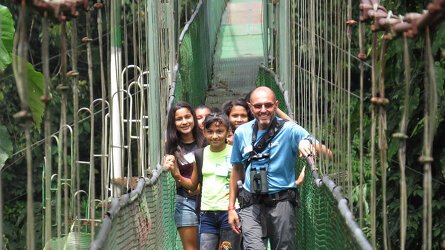
Exodus chooses their Leaders carefully. Professional, dedicated and are passionate about sharing their home countries. Read more
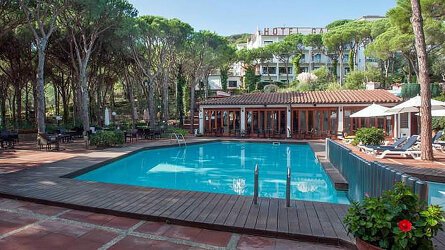
Wherever possible, Exodus chooses properties that are locally owned and that reflect the area you are visiting. Read more
Availability
A definite departure means minimum numbers have been reached for this departure to operate. Your Global Journeys Travel Advisor will check the availability of your departure date when you enquire. Additional savings may apply. We guarantee the lowest price in Australia. T&C’s apply.
Tour & cruises prices are per person. Prices shown have savings applied, are subject to availability and may be withdrawn at any time without notice. Pricing and trip details are correct at this point in time, however are subject to confirmation at the time of booking and are subject to change by Exodus. For cruise itineraries, cabin images are sourced from Exodus. These should be treated as indicative only. Cabin inclusions, upholsteries and room layout may differ to the image(s) shown depending on the ship selected and your sailing dates.
